#pinon pine
Explore tagged Tumblr posts
Text
The Piñon Pine - The Indians Own Tree
When I section-hiked the PCT from Tehachapi to Walker Pass several Mays ago, as we neared the northern end of that trip we took a lunch break one day under a grove of piñon pines. As we reached into our pack for our usual lunch of cheese, rye crackers, and salami, we began to notice that the forest floor was littered with pine nuts. While some had become food for rodents, squirrels, and other foraging animals since dropping to the ground the prior autumn, most were so very edible. Soon we were each on our hands and knees collecting cones and harvesting their delectable contents ($29 a pound at our local co-op). I ate my fill and packed an empty bag with more nuts which I brought home with me when I left the trail. This is David Foscue’s story of the pine nut.
David Foscue
An Evolutionary Feat
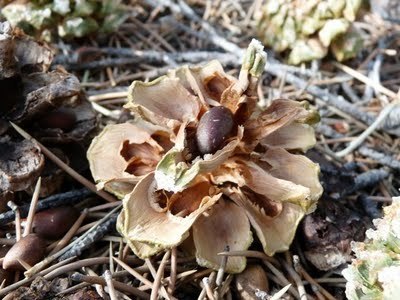
Piñons are coveted for their nutitious seeds. One pound of seeds may contain 3,000 calories. The pine nuts were collected by Indians as stores for the winter. Listen again to Muir: “This is undoubtably the more important food-tree on the Sierra, and furnishes the Mono, Carson, and Walker River Indians with more and better nuts than all the other species together. It is the Indian’s own tree, and many a white many they have killed for cutting it down.”
A diligent collector in the prime collecting time can gather up to seventy pounds of the seeds. Humans, of course, are not the only beneficiaries of the piñon’s largess. Pine nuts are a favorite of many animals from the piñon jay to the pack rat — it is reported that over forty pounds of nuts may be found in a pack rat’s cache. The wide popularity of piñon nuts is a matter of survival, for the seeds of the piñon lack wings and depend on animals for distribution.
The piñon of the Sierras is single-needled pine. It is a mutation of the piñon found further east on which the needles appear in bunches of two. The two-needled piñon is subject to infestation by the piñon spindle gall midge which appears to have evolved with the tree. The insect lays its eggs on the flat leaves, when they hatch the larvae crawl into the crotch between paired needles. The irritation caused by the tiny larvae simulates the plant to grow tissue forming a gall over the larval wound. The gall covers the wound but it also protects the enclosed larvae.
The gall midge evolved to inhabit the single-needled piñon which lack the needle crotches to shelter the larvae. According to Ronald Lanner, the single-needle piñon developed from the twin-needled variety but “one of the potential needle sites is suppressed by the … mutation. Our gall midge neutralizes the mutation. The feeding of the larvae suppresses the needle-suppression mechanism, allowing both of the potential needles to develop, though they reach only a fraction of their full length. The needles are galled and the larvae grow up in the same type of needle-crotch home as those in … two needled pines.” Needles at unaffected locations on the tree remain single.
Kit Carson, John C. Frémont and the Piñon Nut
The piñon played a supporting role in two dramas that have become part of the lore of the PCT. One involved “The Pathfinder,” John C. Frémont, extraordinary adventurer and the first Republican presidential candidate. The other tale involves the ill-fated Donner party.
Frémont, and his scout, Kit Carson, led the first recorded winter crossing of the Sierras. What Frémont expected to take a week became an ordeal of five weeks. As they faced the Sierras their supplies were running low. Fortunately Indians supplied them with pine nuts! On January 24, 1844, Frémont wrote:
A man was discovered running towards the camp as we were about to start this morning, who proved to be an Indian of rather advanced age–a sort of forlorn hope, who seemed to have been worked up into the resolution of visiting the strangers who were passing through the country. He seized the hand of the first man he met as he came up, out of breath, and held on, as if to assure himself of protection. He brought with him, in a little skin bag, a few pounds of the seeds of a pine-tree … . We purchased them all from him.
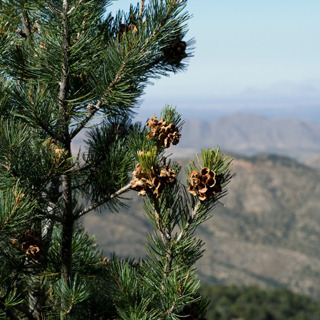
The Donner Party - Rescued by Pine Nuts?
George Donner’s group was not as successful in its attempt to cross the Sierras two winters later. In a snow storm, the party reached what is now known as Donner Lake in early November 1846. Attempts to reach the pass failed and the party returned to the lake and settled in. Although many of their animals froze providing unexpected food, their provisions were soon exhausted and the new settlers faced slow starvation.
On December 16 a group of fifteen left the lake in an attempt to cross the mountains for help. Using the same term Frémont applied to the old Indian who first provided him piñon nuts, they called themselves the “Forlorn Hope Party.” Death reduced the group to seven. As we now know, the dead sustained the living.
The forlorn and depleted party finally came to an Indian village on January 10. The Indians provided acorn bread to the party but the group was so weakened their strength could not be restored. The leader, William Eddy, became sick on the bread. Donner’s Daughter, Eliza, writes how Eddy regained his strength:
… the chief with much difficulty procured for Mr. Eddy, a gill of pine nuts which the latter found so nutritious that the following morning, on resuming travel, he was able to walk without support.
Eddy walked fifteen miles that day to a small settlement where he was able to organize a party to rescue the other six surviving members of Forlorn Hope. Eventually three rescue parties, including one led by Eddy, were organized to return to Donner Lake. Forty-six members of the Donner party were rescued. Forty-two did not make it. The toll surely would have been greater but for the pine nuts given by the Indians to Eddy.
Think about the Donner party the next time you sprinkle piñon pine nuts on your salad.
2 notes
·
View notes
Text

#ryuji suguro#ao no exorcist#blue exorcist#ryuuji suguro#suguro ryuji#suguro ryuuji#bon suguro#episode 5#cram school#as far as i can tell#he wrote 'pinnochio' for that missed answer#and i SO want to know why#did he misspell something?#was it about wooden puppets?#i need answers and will never have them#the only thing i can reasonably think is that the answer was actually 'pinon' (the pine) and he just got that mixed in his brain
3 notes
·
View notes
Text
Fallout and Food - research for all fics
I've been meaning to type this up for ages (I have it as written notes on my iPad), so I thought I'd post this first and if people are interested I can post more research that I've done, since a lot of you said yes to seeing my research!
So I talk about food a lot, in my fics. That's because I love cooking. So one of the first things I did was research food, because as much as I love spam (no joke I miss it most since going vegetarian) I wanted to try and have some diversity in what Cooper and Lucy ate, especially once we got to the ranch, where the residents are permanently settled and food is part of life, rather than a mere thing of sustenance.
There were a few things I focused on in my research, wanting to have meals that could be left whilst work was happening, so I pictured a lot of stews and cassoulets, corn-based porridge, hearty breads etc - but there's no flour. Instead, Mesquite beans can be subbed 1:1 for flour to make a flatbread, and there's a lot of recipes using beer etc, which we know they have, as a raising agent.
A lot of the animals they're eating aren't exactly to our tastes, but knowing that peppers and tomatoes are grown lets us know they can make paprika etc, and the jalapenos in game gave me hope haha! I wrote a smoker into the farm and cold storage so they could a) dry age the meat via hanging, and b) smoke extra flavour into some of the less...appetizing cuts


And for the meat-

Here are some of the meal ideas I noted down-
Meal ideas
Cassoulet of wild beans and meat
If we have agave and corn we can have cornbread
Corn based porridge
Pinon nuts - pine nuts + Jalapeno and coriander could marinade Iguana Nicely
Pickly Pear - can be made into fruit/jelly/fruit cheese (named after the historic moulds, no cheese involved) or sauce for meat
Tacos with black beans and brahmin cheese
Nopales are edible pads of the prickly pear cactus, which can be stir fried
Tepary beans and cholla bud stew
And finally, 10 of my references since you can only put 10 links in, apparently!
#fallout#ghoulcy#fallout fanfic#ao3 writer#fanfiction research#desert food#fallout food#a kiss to build a dream on
72 notes
·
View notes
Photo

's this small batch simngle matlwhiskey they made from like PINE TREES ahaha. Didnyou know that pinecones have NUTS in em?? like theres. It's called a pinon nut i htink.,.. s'what makes the whiskey all yeloworange. haha. hmm? Why are my eyes yellow? ...
57 notes
·
View notes
Text

Sacred Herbs for Smudging
Listed below are some basic properties for various herbs I use at Sage Goddess and, of course, in my own rituals. These herbs have been used for centuries in the Far East, Middle East, Native North, and South American cultures.
Alfalfa – associated with psychic abilities, and attracting animal spirits.
Allspice – for uplifting and increasing energy, and determination.
Amaranth – for healing, protection, vulnerability, especially healing of broken hearts.
Aspen – for ascension, protection, and overcoming fears.
Basil – for attracting love, happiness, peace, and money; steadies the mind.
Bay Leaves – for psychic power, divination, success, and money; invoking wish magic.
Blue Spruce – the symbol of pure intentions, generosity, and giving.
Calendula – for love and constancy.
Catnip – attracts good spirits and great luck. For love, beauty, and happiness.
*Cedar – banishes fear and enhances psychic powers.
Chamomile – for protection and purification.
Cinnamon – when burned raises high spiritual vibrations and aids healing.
Cloves – for protection and exorcism; attracting opposite sex.
*Coastal Sage or Artemisia Californica – for clearing negative energies and healing holes or tears in the aura.
Dandelion – for divination, spirit calling, and wish magic.
Dill – for protection, luck, money, and lust.
Eucalyptus – for healing and protection.
*Frankincense resin – reduces stress, eases tension, and connects you with Source energy.
Ginger – adds power to any magical activity, speeds things up; brings passion.
*Lavender – brings peace, relaxation, and restful sleep; purity and love.
Lemongrass – for cleansing and purifying, removing obstacles, and opening doors.
Lilac – for protection and exorcism.
*Mugwort or Artemisia Vulgaris – brings clarity and develops/deepens psychic abilities.
*Myrrh resin – for physical healing and grounding.
*Palo Santo – for deep healing to the physical body; can be used to clear a home of energies associated with illness.
Peppermint – for purity, protection, release, and renewal.
*Pinon Pine resin – protective, healing, and nurturing.
Rosemary – for removing negative energies associated with sickness, and clearing.
Sage Flowers – for cleansing and releasing negative energies; brings wisdom and purity.
*Thyme – excellent for releasing ceremonies; allows us to recall the past without pain.
*White Sage or Salvia Apiana – used to clear negative energies from objects, space, or people.
7 notes
·
View notes
Text
Ok so like.. 4 months or 80 years ago, I made a post asking if anyone knew of any good candles that really smelled like a campfire or woodsmoke. Well, on that journey, I found these wood incense sticks (and a cute little stand for them). I finally bought them and oh my god!

This is amazing! My bedroom smells like an actual campfire! I feel like I'm in the woods, looking at the stars, listening to crickets, and being the sexiest cowboy in the west. I'm not even exaggerating.
I've only tried the pinon/pine scent so far, but I am in love. I already love this so much that I wanted to share.
#this is amazing#i feel like i just came in from sitting around the fire and the smell is clinging to me#and the stand has different versions#the smoke cones out of the train and it's so cute
9 notes
·
View notes
Text

Summer isn’t over yet. Staples. I don’t like many roses they often make me quease in their strength whether dark, animalic, acrid (winey), they turn sour on my special skin and I HATE that stench of an sour rose. Rōzu, kiehls musk, and rosehip thistle offer a more rosey blush idea enough for me, I guess more rose-watery. I miss my mugler angel rose, that might be my favorite winter rose, rōzu is a good fall rose it has a bit of the michaels flower section potpurrrri smell. The rest of everything is sterile yet earthy for summer, wearing cdg 888 and tea tree oil right now. Obsessive with the pinon hydrosol, gentle pine with loamy mushroom smell. Also duh you need any perfume that smells like yerba, diptyque tempo hid mustve rolled under the bed. N My bedsprays are that love which might be my favorite ylang in any “composition” even if it only has like 4 ingredients. It’s like rosey indolic ylang sweet tarts its so good, and the aura cacia frankincense mmm its lemon lime sterile quality so delicious to spray on my pillows.

7 notes
·
View notes
Text
John Brunner's Squid with Pine Nuts
John Brunner’s recipe for squid with pine nuts: 1 1b. baby squid 1 large onion 1 oz. pine nuts (pinon nuts) 2 oz. butter 1 clove garlic salt and pepper 2 sherry-glasses dry sherry water Chop the onion and garlic fine, brown in the butter. Clean squid, cut into rings, add to pan and add nuts. Season lightly. Stir over low heat until everything is coated with the butter. Add the sherry. Simmer for…
0 notes
Text
Horrors to Honors: The Mountain and Memorials of Emma Crawford
Consisting of three peaks in the San Juan Mountain range of western Colorado, Red Mountain is a sight to behold. Towering approximately 13,000 feet above the earth below, the rock here is rich with iron ore creating a natural color palette ranging from reds and yellow to occasional hues of purple. The mountains and the nearby mineral springs have been important destinations for centuries. The land was originally sacred to the Native American population who used the natural mineral spring water and saw the bubbling as the breath of the Great Spirit and when the town was founded in 1872 by General William Jackson Palmer and Dr. William Abraham Bell it was intended to be a health resort attracting all manner of people aiming to maintain (or gain) their health with the mineral waters, high altitudes, and clean, fresh mountain air. The mountains played an important role in thousands of lives and were cherished by many, but few claimed as deep of a connection with them as Emma.
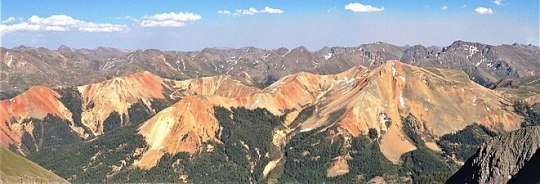
Red Mountain as seen from seen from Imogene Pass, San Juan Mountains of Colorado. Image via Wikimedia Commons user Adam Barhan https://commons.wikimedia.org/wiki/File:Red_Mountain_from_Imogene_Pass.jpg.
Emma Crawford was in her twenties when she moved from Massachusetts to the mountainous region of Colorado. Traveling with her was her mother, a music teacher and pianist that impressed the value of music on Emma at a very young age. By the time she was three years old she preferred listening to her mother playing the works of the old masters on piano to playing with toys and at the age of twelve she was playing in recitals while teaching lessons of her own. As a teenager she played the piano alongside renowned violin and cello players while absorbing the notes and melodies of Chopin, Wagner, and her favorite, Beethoven. When she was not playing piano she took up other instruments with the same stunning level of skill and she quickly became a master at violin, mandolin, cello, and viola.
Emma’s future in music seemed bright but the move nearly across the country was not to enhance her career as a musician, it was intended to heal her. Manitou Springs was founded as a health resort and by the time Emma and her mother started renting their two-story home she had already been suffering from what is suspected to have been tuberculosis for many years. Thousands of people came to the mountains for the springs and air that promised good health, and the Crawfords were among them, uprooting their lives hoping to extend them for many more years.
If music was Emma’s first love it was followed closely by her love of nature and Manitou Spring’s mountains may have seemed like a paradise. She was particularly fond of Red Mountain and claimed she had a spiritual guide, a Native American man “from the spirit world” that protected the family and also beckoned her to climb to the top of her beloved mountain. She of course fully intended on following through with this, but when she informed her mother, her friends, and her fiancé William Hildebrand of her plan they pleaded with her not to go through with it. She was in Manitou Springs because she was ill, the last thing she should be doing is climbing a mountain…but that did not stop her.
It was very late in the evening when Emma returned home and when her mother and Hildebrand asked where she had been she told them the truth. While her mother was teaching a piano lesson she saw her opportunity to sneak out undetected and she made her way to the mountain that called her name. It was difficult for anyone to believe she made it to the top but she insisted she did and that there was proof saying “I did so climb it…and I tied my scarf to a little pinon pine tree on the summit, and I have decided that I will be buried beneath that tree.”
The next day one of Emma’s friends climbed the peak and sure enough, they found her red scarf tied to the tree just as she said and her footprints were still visible marking her journey there and back. Her request to be buried on the mountain was not new, it was something she had stated previously to her family members and although it might have sounded like a morbid form of motivation for the climb, it was not something that came out of nowhere. Emma arrived in Manitou Springs seeking a cure for her illness, but she was having little success. She loved nature, being outdoors in the fresh air, and feeling the sunshine. This combined with the fact that she absolutely abhorred cemeteries made her decision seem obvious and unfortunately, it had to be carried out soon thereafter.
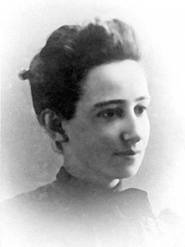
Emma Crawford. Image via http://www.emmacrawfordfestival.com/who-was-emma-crawford.html.
Emma Crawford died on December 4th 1891 at approximately 10:30pm and her obituary stated: “The few who knew her here remarked her calm, unruffled mood, and though her life was such that intimates were few, she was known by nearly all as a musician of rare power and skill.” The funeral services on December 8th were well attended by an eclectic group of people from many different parts of her life. Her mother performed multiple piano pieces of “peculiarly sweet melody and weird harmony” and the Reverend A. R. Kieffer of Grace Episcopal Church led the service, basing his remarks on a poem. Among the attendees were members of the Spiritualist Movement that the Crawford family took part in and one account of her funeral stated that everyone present to pay their respects were “intimate friends and votaries of the faith to which the deceased was an adherent.” When the services were over the next step would have obviously been committing the deceased to their eternal place of rest, but this was no simple task.
When Emma returned from climbing Red Mountain that day she made her wishes very clear. She tied a scarf to a tree and that is where she wanted to be buried, where she could forever remain surrounded by the natural wonder of her favorite place. Knowing this, and knowing Emma’s feelings on cemeteries, the next step was obvious to her fiancé and family. It was going to be difficult, but Emma was going up the mountain. Her casket was taken by hearse to Red Mountain and then twelve pallbearers worked in shifts, carrying it up the peak and to the top where she was finally laid to rest beneath her selected tree, covered by a layer of rocks.
This should have been the end to the story of Emma Crawford, a young woman who died too soon and was buried in her favorite spot due to feats of strength and the tenacity of her pallbearers. But, in 1912 an issue arose when construction to install a power station on the mountain put her final resting place squarely in the path of the work. Her body was exhumed and her remains were re-buried on another side of her beloved mountain. Unfortunately, this was still not the end for Emma. When the 2nd grave was dug it was done so haphazardly and her coffin was put inside covered with lose dirt, any and all rocks, and left with little thought given to the burial being “proper” or safe.
In August 1929 two boys playing on Red Mountain had the shock of their lives when they found a human skull sitting among the rocks. They went to the authorities who searched the area and found more bones and a metal handle. The boys were questioned about their findings but everything became clear when a metal nameplate was found etched with the familiar name “Emma L. Crawford.” She adored the mountain, it was her favorite place, but after she was buried the 2nd time the remains of Emma became a victim of her environment and after years of rain and erosion her coffin…and she herself…became dislodged and slid their way down the mountain.
By the time the pieces of Emma were discovered and gathered up there was no living family to come claim her remains that were moved to City Hall. It was there that they sat for over two years until one of her former pallbearers finally took responsibility for burying her for the third time. When it finally happened she was committed not to Red Mountain again, but to an unmarked grave in the nearby Crystal Valley Cemetery.
The pieces of Emma Crawford lay in rest for nearly seventy years before her name started to be a frequent topic of conversation yet again. The Chamber of Commerce of Manitou Springs were looking for ideas to boost tourism to their town and with a story as unusual as Emma’s they decided they needed to make her and her tale more well known. In 1995 the city launched their new event. Dedicated to Emma and set to take place every October, the event has grown enormously in popularity and people travel far and wide for their chance to take part and to purchase a newly designed commemorative t-shirt.
The event is Manitou Spring’s annual Emma Crawford Coffin Races.
Every year participants in this festival build their own highly decorated “coffin” carts, dress up in costumes, and gather at Manitou Avenue. When the time comes teams of 4-6 people (4-5 people pushing and pulling the coffin-cart with someone dressed as an Emma inside of it) race down the avenue and up a hill to victory. Groups are judged for different categories including Best Entourage, Best Coffin, Best “Emma,” and fastest time. The race, along with the festival and parade of hearses in the name of Emma Crawford has become one of the area’s most treasured Halloween traditions.
In 2004 Historic Manitou Springs, Inc. granted Emma a memorial “gravestone” placed on Red Mountain in the region where it is believed her final wish was initially honored. But, like her multiple burials, Emma also has multiple memorials and in 2023 another marker was placed to honor Emma on Manitou Avenue, the same stretch of road where thousands of people gather every year to honor her and her story with their handmade coffins.
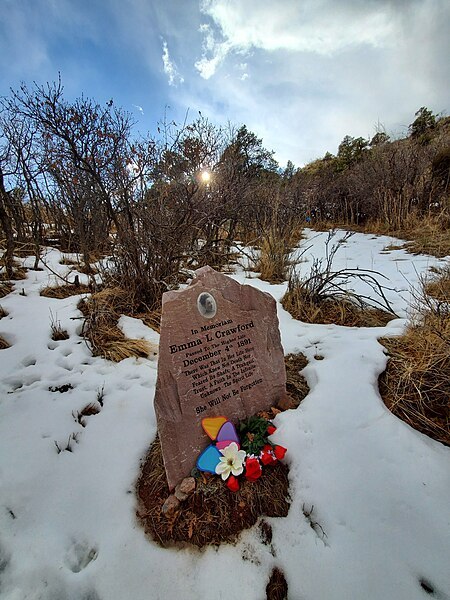
Image of the Emma Crawford marker on Red Mountain. Image via Wikimedia Commons user ForgottenColorado https://commons.wikimedia.org/wiki/File:Emma_Crawford_Headstone_in_Crystal_Valley_Cemetery_in_Manitou_Springs.jpg
To see images and video from previous Emma Crawford Coffin Races please click here
*******************************************
Sources
“Emma Crawford Coffin Races & Festival: Manitou Springs, Colorado.” Manitou Springs, October 24, 2024. https://manitousprings.org/emma-crawford-coffin-races/.
Hazel, Jess. “The Spirit of Manitou Springs Is Alive with the Emma Crawford Coffin Races.” Colorado Public Radio, October 27, 2023. https://www.cpr.org/2023/10/27/manitou-springs-emma-crawford-coffin-races/.
Washburn, Kim. “RIP: Rest in Peace Emma Crawford.” Springsmag Colorado Springs, October 31, 2023. https://springsmag.com/rip-rest-inpace-emma-crawford/.
“Who Was Emma Crawford?” Emma Crawford Coffin Races & Festival, n.d. http://www.emmacrawfordfestival.com/who-was-emma-crawford.html.
#husheduphistory#featuredarticles#history#forgottenhistory#strangehistory#weirdhistory#truth is stranger than fiction#tragictale#ColoradoHistory#LocalLegends#LocalEvents#EmmaCrawford#CoffinRaces#weirdfestival#LocalFestival#ManitouSprings
0 notes
Text

Emma Crawford was a beautiful young woman, only in her early 20s when she arrived in Colorado with her mother. She was an especially talented musician, whose playing was described as being “distinguished by a most delicate touch, a soulful expression, and a power which seemed almost incredible by hands so tender and delicate.” She was also sick. Tuberculosis, they say. That’s what brought Emma to Manitou Springs in the first place, one of the many seeking a cure in the town’s waters. One day, against the advice of, well, everyone, Emma took it upon herself to climb to the top of nearby Red Mountain. Of course, nobody believed her when she returned. Her response to their skepticism? “I did so climb it, and I tied my scarf to a little pinon pine tree on the summit, and I have decided that I will be buried beneath that tree.” And so, she had. Emma Crawford succumbed to the disease on December 4, 1891, and teams of pallbearers bore her to her grave under the tree she’d picked out. Emma had always loved nature, and been afraid of cemeteries, so being laid to rest on the mountaintop was the perfect ending to her short but brilliant life. Or it would have been, had the cog railway not decided just a couple years later to build a power house right on her gravesite. (RUDE!) Now to be fair, the railway didn’t just plop the building right on top of her. No, they arranged for her remains to be moved to a new grave in loose gravel on the other side of the mountain. All was fine then, until the Summer of the Storms. 1929 saw two huge storms that washed Emma’s grave away and sent her coffin racing down the mountainside. The slide destroyed her coffin and scattered her remains. In the end, only her skull and the nameplate from her coffin were recovered; everything else was lost. Manitou Springs would spend the next 2 years trying to find a relative to claim what was left of her, but to no avail. Finally, a Manitou Springs resident arranged for her to be buried in an unmarked grave in Crystal Valley Cemetery, where her body lies to this day. This doesn’t seem to sit well with Emma, though. To this very day, her Spirit still walks Manitou Springs. She’s most often seen on Red Mountain, frequently along the track her coffin raced down. However, she’s shown up almost everywhere in the town. They say she’s not mean, not vengeful, no angry Spirit, but you can tell that she’s not happy with how things are. And that she’ll keep haunting Manitou Springs until she’s returned to her grave under her tree at the top of Red Mountain. To honor their favorite ghost, each year Manitou Springs holds their Emma Crawford festival. The highlight of the festival is the annual coffin race, where riders in coffin-shaped carts are pulled along a course by a team of four pall bearers. No reports of whether Emma herself has ever attended the races.
0 notes
Text
Have you ever taken a bite of food that transported you back in time? Where scents, flavors, and textures collided to create a sensory journey, leading you down the path of history and culture? This is the power food holds, a potent storyteller, preserving the essence of a people and their deep-rooted connection with nature. Now, imagine a humble nut doing just that – serving as a culinary bridge between the past and the present, connecting a community while nourishing both body and spirit. This is the tale of the piñon nut in Apache cuisine.
Image generated by the author
The Piñon Nut: A Culinary Symbol of Resilience
Under the expansive blue skies of the Southwestern United States, rugged terrain stretches out, dotted with piñon pines. These hardy trees, survivors in a harsh landscape, offer up a precious bounty every fall - the piñon nut. For centuries, the Apache people have relied on these nuts, integrating them into their diet and culture in various forms.
The piñon nut is a testament to nature's bounty and adaptability. These nuts, harvested in the heart of fall, are not just a source of sustenance but a symbol of resilience. Roasted as snacks, stewed in heart-warming meals, or baked into pastries, piñon nuts are a versatile ingredient that adds richness and depth to traditional Apache recipes.
Breaking Bread and Building Bonds: The Communal Aspect of Piñon Nuts
Imagine a crisp autumn day, where the air is tinged with the scent of pine needles. Families gather beneath the piñon trees, their hands working in unison to harvest the ripe nuts. This is not merely an exercise in gathering food. It's a communal activity that strengthens the bonds of kinship and reestablishes a connection with the land.
Sharing a meal featuring piñon nuts, whether it is the savory Pinon Nut Stew or the sweet Pinon Nut Bread, is more than just a gastronomic experience. It's an act of hospitality, a reinforcement of community ties. These shared meals, rich with the flavor of piñon, are also spiritual gatherings, serving as a reminder of the teachings passed down through generations.
A Taste of Tradition: Apache Recipes Featuring Piñon Nuts
Imagine biting into a piece of Pinon Nut Bread, the nutty flavor mingling with the soft, warm dough. Or savoring a spoonful of Pinon Nut Stew, where the earthy taste of the nuts complements the robust flavors of the stew. These dishes, passed down from generation to generation, showcase the culinary ingenuity of the Apache people, who have harnessed the flavor potential of piñon nuts to create a unique culinary identity.
Notable experts like Dr. Juanita P. Merritt, a Cultural Anthropologist, and Dr. David R. Wilkins, an Ethnobotanist, affirm the integral role of piñon nuts in Apache diet and culture. The nuts' versatility is highlighted in dishes ranging from salads and casseroles to homemade granola bars and energy bars, asserting the richness of natural, locally sourced ingredients in Apache cuisine.
Piñon Nuts in the Modern Palate: A Return to Nature
Fast forward to our contemporary diets, and we find piñon nuts as a nutritious addition that fits perfectly into our health-conscious ethos. Their use promotes sustainable practices, supports indigenous communities, and encourages a return to nature. Plus, the act of sharing piñon-infused dishes can spark transgenerational conversations, helping younger generations understand and appreciate their cultural heritage.
Honoring Traditions, Fostering Connections
Ultimately, the story of piñon nuts in Apache cuisine is not just about food. It's about honoring traditions, fostering connections, and maintaining a bond with the land. It's about the resilience symbolized in the hardy piñon trees and the sense of community strengthened during harvests and feasts.
As we incorporate piñon nuts into our meals, share these recipes with others, and respect the traditions that connect us to nature, we do more than just feed our bodies. We nourish our spirits, honor our shared heritage, and create a bridge between our past and our present.
So, as we savor the nutty flavor of piñon in our dishes, let us remember the Apache wisdom that teaches us about resilience, community, and the importance of our relationship with nature. For, as we chew on the humble piñon nut, we are not just tasting a nut, but we are partaking in a rich, culinary legacy that connects us to the land and to each other.
AI Disclosure: AI was used for content ideation, spelling and grammar checks, and some modification of this article.
About Black Hawk Visions: We preserve and share timeless Apache wisdom through digital media. Explore nature connection, survival skills, and inner growth at Black Hawk Visions.
0 notes
Text
FULL GG OC





Her name is Pinon (a kind of pine tree) and they use She/they, are ace, and she is 15.8(almost sixteen) and had a magpie palisman pre TTT named jam, and had hunter carve a starling in the timeskipped which they named marmalade! in the timeskip, she works as a reseacher in the biology of the BI! her disend, (like all other ocs of mine) is HEAVELY inspired my irl me!
from top left to bottom,
time skip, post possession, pre possession s3, GG casual, GG.
1 note
·
View note
Text
new mexico state facts
colorful state land of enchantment
home of capulin volvano
1st atomic bomb july 16, 1945 Jornada del muerto
one of the youngest state 1912
old state capital
illegal for women to appear in public unshaven in carrizoz new mexico
home to the shovel race championship
hot air ballooning capital of the world
santa fe is 1607 oldest town
doc holliday from new mexico
ufo reports
taos pueblo is over 900 years old
bandelier national momument largest and oldest 33,000 acres 11,000 years old
500 fossilized dino tracks
the four corners
state hood 1-6-1912
state capital snata fe
largest city albuquerqe
state size 121,589 sq miles
population 2,113,344
4 famous people
1 nobel prize
state mottoe it grows as it goes
state tree pinon pine
state amphibian spadefoot toad
state animal black bear
state bird greater roadrunner
state butterfly sanda hiarstreak
state fish rio grande cutthroat trout
state flower yucca
state fossil coelophysis
state gem turquoise
highest point wheeler peak 13,167ft
lowest point 2,844 red bluft
length 370 miles
width 343 miles
state insect trantula wahkwasp
state reptile whiptail lizard
state veg chile and frijoles
0 notes
Text
Argo:swift
Pine:
Middle English pinen "cause to starve" (c. 1300), from Old English pinian "to torture, torment, afflict, cause to suffer," from *pīn (n.) "pain, torture, punishment," from a general Germanic word (compare Middle Dutch pinen, Old High German pinon, German Pein, Old Norse pina), all possibly ultimately from Latin poena "punishment, penalty" (see penal). If so, the Latin word probably came into Germanic with Christianity.
I believe the Argo is under pine Island and the definition of pine as a verb is to make one suffer or to starve someone out and Argo means Swift or swiftly so you swiftly making someone suffer and starve and also means fat and bloated and it's saying that about myself and others here but I think it's when the ship is launched and I think they were having my claim build them and they were naming them just like they make the currency numbered but unfortunately the currency that's numbered it was enacted here it's probably money that I'm not using but people have to check and make sure it's still there if it's still there it's my money that they coded and they're simply used using the people that they're acting like to send out the code over and over
Zues
There's something that ties it in and it definitely is not you guys getting the ship it's the max of plan to take it cuz they had it made
Hera I'm saying it about us but we have arguments most of which we can't use but we're going to use this one
We're getting ready for a little more here and the macaronis are saying they're going to start bothering us I'm really it's just our son it's going to f*** them up because they're stupid
Olympus
0 notes
Text
Fun fact, “Boy Staring at An Apparition” inspired one of my short stories, “Watching Over Me”!
“I was in my room when the angel first spoke to me.
“I come from Heaven,” it said. “I need your help.”
I didn’t know whether it was lying. I wasn’t scared even though I felt small. Small, and not fit to walk on angelic, blessed ground. In the Bible story, Moses took off his sandals, because the ground was holy. I slipped off my high tops, as a precaution.
Angels were holy, I knew.
…
It leaned close, and I felt heat, hot breath in my ear. It was the exact smell of pinon pines in the Sangre de Cristo mountains. The hot breath spoke of sprouting plants breaking through seed husks. It spoke of molten fire tearing through the foothills. It was the heat of the Earth itself, baked and cracked in the afternoon sun.
“Stay with me,” it said, and I nodded.”
https://fabulistmagazine.com/watching-over-me/
SET FIFTEEN - ROUND TWO - MATCH FOUR


"Lágrimas De Sangre (Tears of Blood)" (1973 - Oswaldo Guayasamin) / "Boy Staring at an Apparition" (1824–25 - Francisco Goya)
LÁGRIMAS DE SANGRE (TEARS OF BLOOD): although this video will do a much much better way of explaining the painting -> https://www.youtube.com/watch?v=708VY9l-Ids here's the summary -> in 1973, after the coup d'état in Chile replacing the democratically elected president Salvador Allende for the military dictator Augusto Pinochet, Oswaldo Guayasamin, an Ecuadorian artist painting a horrifying picture of United States Imperialism: Lagrimas de Sangre. please please give the video a watch, it's around 12 minutes long and it just guts you out i specifically love the way he was able to convey genuine terror through his art piece. (anonymous)
BOY STARING AT AN APPARITION: [no additional commentary] (anonymous)
"Lágrimas De Sangre (Tears of Blood)" is an oil on canvas painting by Ecuadorian artist Oswaldo Guayasamin. It measures 55 1/10 × 39 2/5 in (140 × 100 cm) and is probably held by Fundación Guayasamín, Quito.
"Boy Staring at an Apparition" is a piece done with a carbon black wash, with watercolor and scratching, on ivory. It is by Francisco Goya, and is the smallest piece in the tournament at 5.9 x 6 cm (2 5/16 x 2 3/8 in.). It is held by the Museum of Fine Arts, Boston and is not currently on display.)
35 notes
·
View notes
Photo
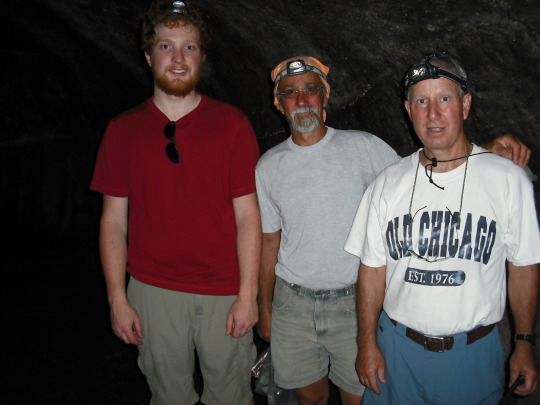
PCT Quiz #8. This is one of the few places along the PCT where you need headlamps no matter how bright the day is.
The answer to Quiz #7 is McIver’s Cabin (and, more importantly, spring). Just a .3 mile detour from the trail and the best water for miles, this spring lies 8 miles south of Walker Pass. Although hunters, motorcyclists, and OHV riders have used it for years (and, there can be unsightly litter as proof), it does tend to be an oasis surrounded by a pinon pine forest.
The modest cabin was purchased in 1938 by Murdo George McIver and moved from Sand Canyon, where it was used in building the Los Angeles Aqueduct, to its present location. McIver selected the location due to its proximity to his mining claim and a source of natural spring water, later named McIver’s Spring.
Happy winter solstice.
4 notes
·
View notes